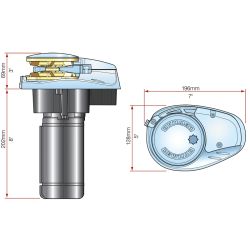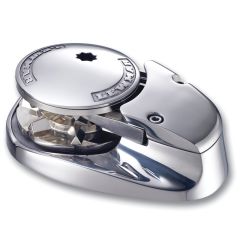700 lb Max. Pull Typical Boat Length up to 32 ft
With a highly polished, all 316 stainless steel housing and a sleek flush-mount design that hides the motor down below, the V700 is one of the most attractive and durable windlasses on the market. It works at the push of a button and has two built-in features that make it unique motor protection and anchor lock. Plus, its affordable.
The V700 comes with a rope/chain gypsy able to accept both 6mm and 7mm, and 1/4" BBB or HT chains. (Lewmar refers to this as a "dual chain" gypsy.)
The V700 is available in two versions:
- As a windlass only (with mounting studs, deck gasket, clutch wrench)
- Or as a Kit - which adds a Switching Package: up/down rocker switch, a dual direction solenoid (contactor), and a circuit breaker. The Kit version is, by far, the most popular.
Suitable for most boats up to 32 ft in length
Fits calibrated chains: 6mm DIN766, 1/4" G4 or BBB, 7mm DIN766
For rope, chain, or combination rodes (3-strand or 8-plait rope required)
Built-in motor protection and Fail Safe anchor lock
Minimal parts for enhanced reliability
Easy, owner installation
316 stainless steel deck unit
IP67 rated housing - rated for temporary immersion
Fast line speed
Manual recovery option
Impact-resistant motor cover
Minimum recommended deck thickness is 1" (25mm); supplement with a suitable backing plate, if necessary
Note that G4, G40, G43, and High Test (HT) chains are equivalent for sizing purposes
5-year warranty
Is one of these windlasses a good choice for your boat? You can use the recommended typical boat lengths provided or, for a more rigorous determination, take the total weight of your ground tackle (anchor + rode) and multiply by 4. The maximum pull capability of the windlass should be at least as large as the resulting number.
Heavy on the technical side...size="3">
Horizontal vs. Vertical Windlass Selection
Windlasses can be divided into horizontal and vertical models, differentiated by their drive shaft orientation.
Horizontal windlasses are typically entirely above deck, and present a more "traditional" look. Surface mounting usually makes for easier installation (especially on very thick decks, or if there is limited access below), and means the motor does not take up valuable locker space if your boat has a smaller or shallower chain locker. A minimum "fall" from the gypsy to the top of the piled up rode of at least 12" is recommended in order to have enough weight to pull the rode down into the locker. Especially if a portion of your rode is rope, more fall is better. The anchor chain engages only about of the chainwheel (gypsy) circumference on horizontal windlasses, making a good match of the chain size to the gypsy particularly important. Horizontal windlasses can be somewhat more forgiving than vertical models if the anchor/bow roller is located higher than the windlass chainwheel - out on a sailboat bowsprit, for example. They are also the better choice if two anchors must be handled from one windlass, as each side can be fitted with a gypsy or gypsy/capstan.
Vertical windlasses are extremely popular. With their motors below deck, they take up less space on deck and present a more modern "low profile" appearance, but with the drawback of having the motor located in a relatively damp environment. A minimum "fall" of at least 18" from the underside of the deck to the top of the piled up rode in the chain locker is recommended in order to have enough weight to pull the rode forward from the chainwheel and then down into the locker. So vertical windlasses are more suitable for boats with larger, deeper chain lockers. The anchor chain engages approximately of the circumference of the gypsy giving optimal chain control and minimizing jumping.
Both horizontal and vertical windlasses are typically available with or without a capstan drum for independent hauling of a second rode, halyard, tow rope, etc. On vertical windlasses equipped with a warping drum, or capstan, the line pull can be from any direction, as opposed to fore and aft only on similarly equipped horizontal windlasses.
Windlass Size Selection
Although it is tempting to size a windlass by ascribing a "typical" boat length, a more rigorous and nearly as easy method is to determine how much pulling power your windlass should have.
This is easily done by taking the total weight of your ground tackle (anchor plus rode) and multiplying by 3 (or 4 if you are more conservative), as a safety factor to prevent overloading the windlass during a prolonged retrieval.
The windlass you select should have a maximum pulling power of at least this number. So, a windlass for a 60 lb anchor with 200 feet of 3/8" HT chain should have a pulling power of at least (60 + (200 x 1.5 lb/ft)) x 4 = 360 x 4 = 1440 lb pull required. (We allow for the possibility of having to retrieve your entire ground tackle in deep water should you "drag anchor" with it fully deployed.)
Remember... it is your ground tackle, not the windlass, that is sized for your boat. The 320 lb ground tackle mentioned above would require the same size windlass whether it were on a 24 ft tug or a 48 ft racing sailboat.
Having said that... circumstances can arise where, despite all your planning and calculating, your windlass may be subjected to unanticipated extreme loads say, while retriving your anchor during a storm.
To be prepared for such a situation, if your boat has a particularly high displacement for its length, or if it has a hull shape or above deck structures that present a lot of surface area to the wind (high windage), you should consider moving to the next larger size when selecting your windlass for more reserve power.
Lying At Anchor and "Best Practices"
A windlass is not a high-load bearing device.
Although they are very strong, no windlass drive shaft is designed to withstand the potential shock loads generated by wind and heavy seas in a stormy anchorage.
To prevent damage, good seamanship dictates that windlasses should always be used in conjunction with a chain stopper, rode snubber, or mooring cleat to carry the load when lying at anchor.
Likewise, your main engine, not your windlass, should be used to motor up to and break free your anchor leaving the windlass only the task of pulling it up.

